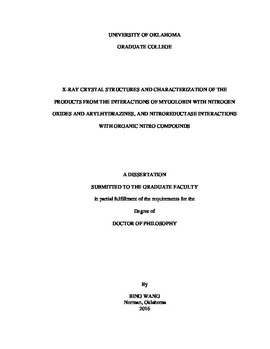| dc.description.abstract | This thesis describes research into the roles that metalloproteins and non-metalloproteins play in the biological inorganic/organic chemistry of common nitrogen oxides. There are three main chapters on this work: the first details the reactions of wild-type and mutant myoglobins (Mbs) in their interactions with nitrite and nitric oxide (NO), the second deals with these Mbs and their formation of bioorganometallic derivatives when reacted with arylhydrazines, and the third deals with an FMN-dependent nitroreductase enzyme and its reactions with the clinically relevant metronidazole drug.
Mutations to the distal pocket in the active site of Mb were made; specifically, ferric-aqua derivatives of the mutants were expressed, purified, crystallized, and their crystal structures solved to 1.78-1.85 Å resolution. The proteins crystallized in either the P21 or P6 space groups. The crystals were soaked with nitrite to form their O-bonded MbIII(ONO) complexes whose structures were also solved to 1.57-1.85 Å resolution. In the case of the H64A distal pocket mutant missing the H-bonding amino-acid residue in the 64th position, a water bridge was observed to form linking the protein exterior with the bound nitrite ligand, thus replacing the expected wt H64 H-bonding feature. Further, we noted that the distal pocket Val68 residue adapted its conformation to accommodate the nitrite ligands in some of these complexes. Notably, the O-binding modes observed in the four wt and mutant structures held up exceedingly well even with the variation in H-bonding capacities. These wt and mutant Mb(ONO) compounds can be reduced with sodium dithionite to their respective nitrosyl Mb(NO) products. Verification of the formation of the nitrosyl Fe-NO derivative, and not the closely related nitroxyl Fe-HNO, was provided by FT-infrared spectroscopy.
Arylhydrazines and derivatives are prevalent in nature and in pharmaceutical drugs. They interact with various heme proteins resulting in deactivation of the proteins. Eleven X-ray crystal structures of the products from the reactions of wt and mutant (H64A, H64Q, V68A/I107Y) Mbs with arylhydrazines (ArNHNH2; Ar = Ph, m-tol, and p-chlorophenyl) were obtained to 1.70-1.98 Å resolution. Direct Fe-carbon bonds were observed in all these derivatives, establishing that the hydrazine -NHNH2 moieties had been released from the reagents during their reactions with the Fe centers of the Mbs. Importantly, the C-atoms coordinating to the Fe centers were the same as those that bonded to the hydrazine functional groups, implying that the carbon-based radical intermediates were formed in close proximity to the Fe centers allowing for facile and efficient reactions to give the bioorganometallic Mb-aryl products. Significant distal pocket amino acid movements were observed in some cases with the larger p-chlorophenyl ligand aryl; for example, in the H64Q-chlorophenyl derivative, the Gln64 residue swings to a position outside the pocket towards the solvent region.
We report the first expression, purification, crystallization, and X-ray crystal structure of a nitroreductase (NR) protein from Clostridium difficile. This NR protein was isolated in dimeric form, and possesses the classical NR fold, with one FMN cofactor per monomer. The crystal structure was solved to 2.1 Å resolution, and shows a phosphate anion in one of the active sites. | en_US |
